Growing a Candy Tree in the Open Air
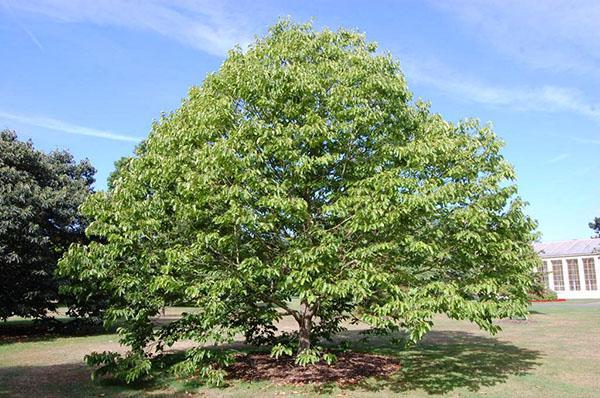 Sweets are not only cookies, cakes, chocolate or marshmallows, but also a real candy tree. It is thanks to the sugary taste of its twigs that it got its name. The second name of this exotic culture is Govenia. At one time, the German Senator Gove financed an expedition to the researcher Thunberg, who observed and later described this perennial plant. The feeling of gratitude prompted the naturalist to capture the name of the politician in the pages of botanical literature.
Sweets are not only cookies, cakes, chocolate or marshmallows, but also a real candy tree. It is thanks to the sugary taste of its twigs that it got its name. The second name of this exotic culture is Govenia. At one time, the German Senator Gove financed an expedition to the researcher Thunberg, who observed and later described this perennial plant. The feeling of gratitude prompted the naturalist to capture the name of the politician in the pages of botanical literature.
Read also about a coffee tree.
Welcome to your hometown of Govenia
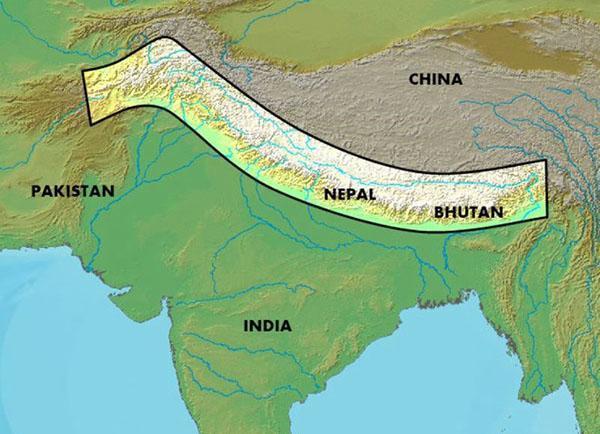 Such a luxurious tree can only be found in a subtropical climate. It perfectly tolerates both dry periods and rainy seasons. The birthplace of the candy tree is:
Such a luxurious tree can only be found in a subtropical climate. It perfectly tolerates both dry periods and rainy seasons. The birthplace of the candy tree is:
- China (central zone);
- Japan;
- India (Himalayan mountains);
- South Korea.
Subsequently, this culture began to be grown both on the European continent and in the coastal regions of the Black Sea (Caucasus, Crimea, Sochi region). In botanical gardens, nature reserves in South America, as well as in the North African states, Govenia can be found only in the form of decorative exhibits.
 In the homeland of this plant, its wood is highly valued. It has a scarlet hue, which resembles solid mahogany. Culture is not devoid of valuable technical properties. Due to its unique strength, wood is used in the production of expensive furniture.
In the homeland of this plant, its wood is highly valued. It has a scarlet hue, which resembles solid mahogany. Culture is not devoid of valuable technical properties. Due to its unique strength, wood is used in the production of expensive furniture.
Some of the great maestro's musical instruments were made from the trunk of this amazing plant.
"Oh, noblewoman, beauty lepa ..."
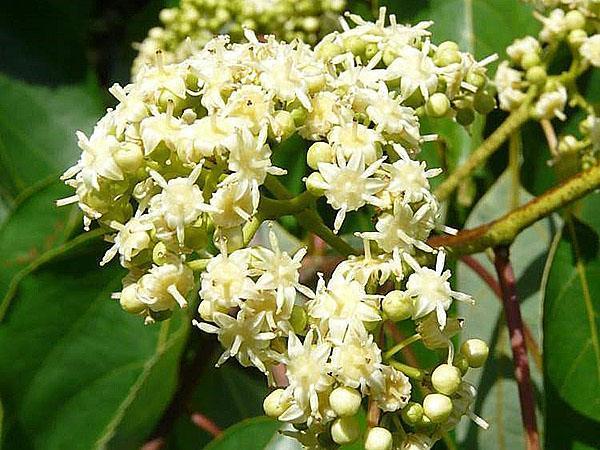 Tourists pronounce this beloved line of a comedy character as soon as they see the dense spherical crown of a "sweet" tree. It consists of thousands of densely planted oval-shaped leaves (15 cm long each). Their characteristic features are:
Tourists pronounce this beloved line of a comedy character as soon as they see the dense spherical crown of a "sweet" tree. It consists of thousands of densely planted oval-shaped leaves (15 cm long each). Their characteristic features are:
- glossy texture;
- dark green color;
- alternate arrangement on the stem;
- light underside with fluffy veins;
- dense and slightly rough structure.
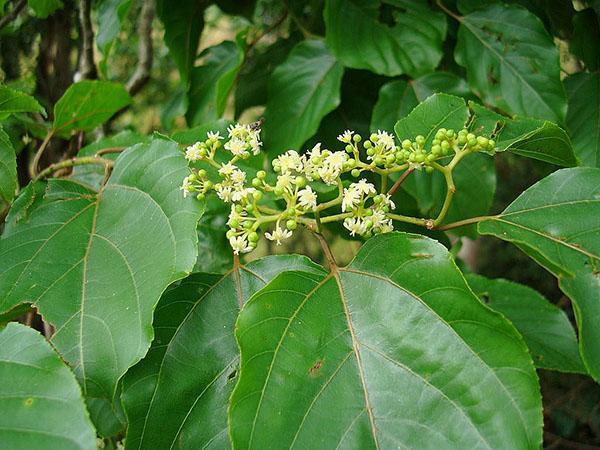 In June or July, the Govenia candy tree throws out exquisite blossoms. It is for this delightful charm that many have come to love her. Small (d = 8 mm) and with a heady aroma, the flowers are collected in large inflorescences, reminiscent of feather fans. All shoots are decorated with these snow-white blossoms. Combined with green leaves, they create a pompous look. Closer to the July heat, flowers begin to acquire a creamy color. Along with this, it is also worth mentioning:
In June or July, the Govenia candy tree throws out exquisite blossoms. It is for this delightful charm that many have come to love her. Small (d = 8 mm) and with a heady aroma, the flowers are collected in large inflorescences, reminiscent of feather fans. All shoots are decorated with these snow-white blossoms. Combined with green leaves, they create a pompous look. Closer to the July heat, flowers begin to acquire a creamy color. Along with this, it is also worth mentioning:
- brownish gray bark;
- 15-meter plant height (ornamental home varieties reach 150 cm);
- straight, and most importantly, perfectly flat trunk, which is more than 75 cm in diameter.
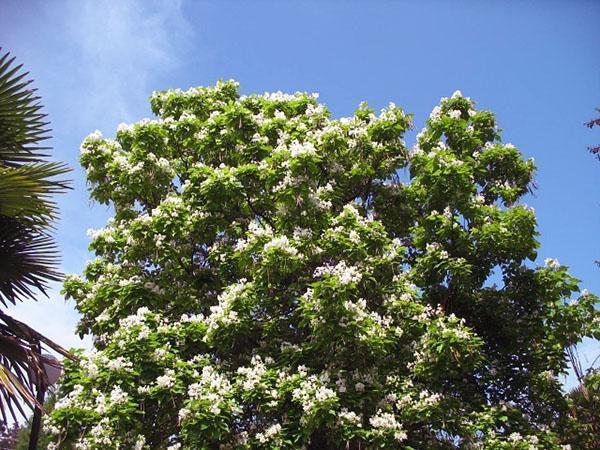 All this makes the subtropical "curly beauty" the most valuable asset of Asia. Now it is worth paying attention to the exceptional feature of the fruit of the candy tree, photos and descriptions of which deserve a separate item.
All this makes the subtropical "curly beauty" the most valuable asset of Asia. Now it is worth paying attention to the exceptional feature of the fruit of the candy tree, photos and descriptions of which deserve a separate item.
Amazing paradox
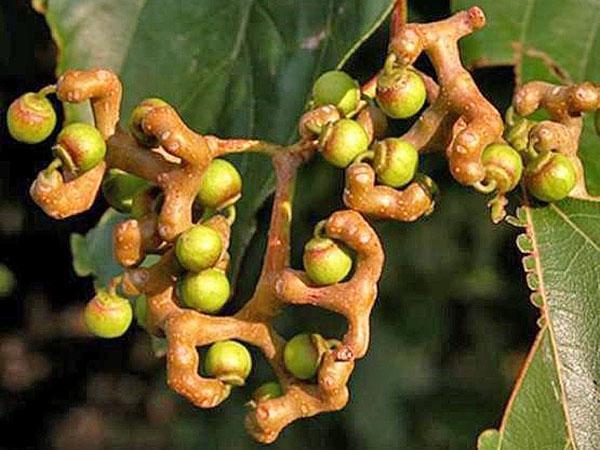 Deciduous govenia differs from all representatives of the Buckthorn family by its outstanding fruits and stalks. Of these, you can only eat shoots, because the miniature boxes with brown satin seeds are not very tasty. All the sweetness and "sugar reserves" are concentrated in the fleshy stalks. At the last stage of flowering, they begin to swell and harden slightly.At this time, the outermost part of the brown branches takes on a reddish tint, which is a sign of maturity.
Deciduous govenia differs from all representatives of the Buckthorn family by its outstanding fruits and stalks. Of these, you can only eat shoots, because the miniature boxes with brown satin seeds are not very tasty. All the sweetness and "sugar reserves" are concentrated in the fleshy stalks. At the last stage of flowering, they begin to swell and harden slightly.At this time, the outermost part of the brown branches takes on a reddish tint, which is a sign of maturity.
They become especially tasty after freezing. Some gourmets share that frozen sugar stalks resemble sweet raisins in tandem with aromatic melon. And when chewing, you can feel a light taste of an alcoholic drink - rum.
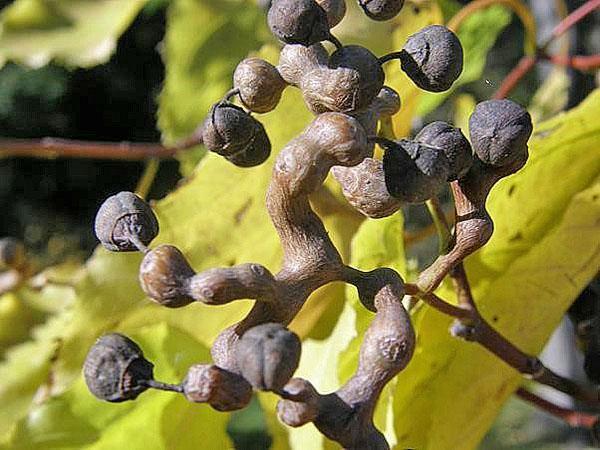 When the plant reaches 25-35 years of age, more than 34 kg of these juicy twigs can be harvested from it. If you dry or dry them a little, you will end up with a real analogue of sugar. Shoot pulp contains up to 45% carbohydrate compounds. The remaining 55% falls on:
When the plant reaches 25-35 years of age, more than 34 kg of these juicy twigs can be harvested from it. If you dry or dry them a little, you will end up with a real analogue of sugar. Shoot pulp contains up to 45% carbohydrate compounds. The remaining 55% falls on:
- fructose;
- proteins;
- ascorbic and malic acid;
- vitamins;
- glucose;
- potassium nitrate.
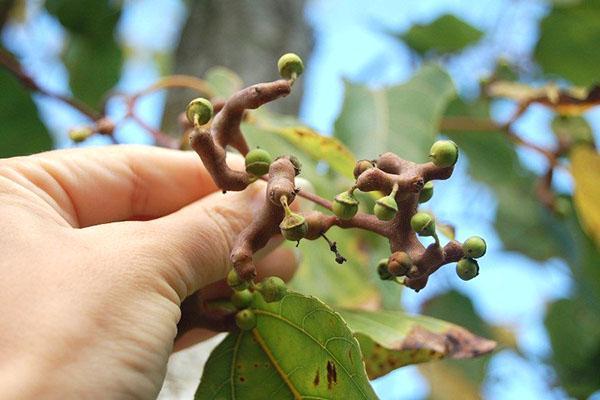 Confectionery enterprises use fresh or pressed stalks for the production of various sweets. Alcohol companies also use these herbal products as beverage additives (from the beer and rum series). All kinds of extracts are obtained from young leaves, seeds, and branches. According to their taste and medicinal characteristics, they freely replace honey. At the same time, the fruits of fasting contain a lot of proteins and fats. Therefore, they serve as an excellent addition to sports nutrition.
Confectionery enterprises use fresh or pressed stalks for the production of various sweets. Alcohol companies also use these herbal products as beverage additives (from the beer and rum series). All kinds of extracts are obtained from young leaves, seeds, and branches. According to their taste and medicinal characteristics, they freely replace honey. At the same time, the fruits of fasting contain a lot of proteins and fats. Therefore, they serve as an excellent addition to sports nutrition.
Healer by nature
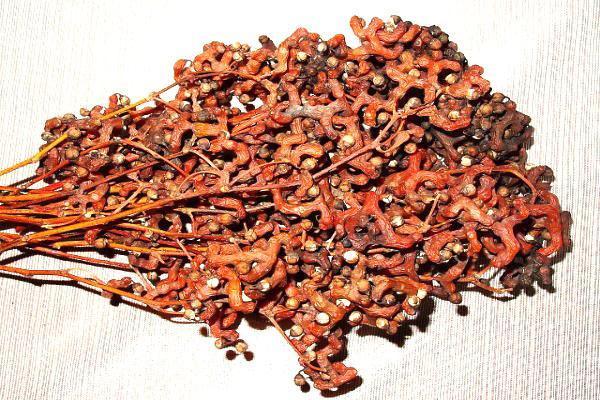 Like all other varieties of the plant world, the candy tree is widely used in medical practice. Constipation and fever can be treated with decoction from the stalks. But with gruel from the fruits, Asians heal burns, wounds or bruises. In addition, drugs based on these elements are used to treat:
Like all other varieties of the plant world, the candy tree is widely used in medical practice. Constipation and fever can be treated with decoction from the stalks. But with gruel from the fruits, Asians heal burns, wounds or bruises. In addition, drugs based on these elements are used to treat:
- pneumonia;
- nervous disorders;
- hypertension;
- headaches;
- gallstone disease.
 A strong decoction is made from the bark of perennial plants. Doctors attribute this drink to patients who suffer from intestinal diseases. Ground seeds are taken for all kinds of poisoning, as well as to alleviate the course of the hangover syndrome. This flour is also used as a diuretic.
A strong decoction is made from the bark of perennial plants. Doctors attribute this drink to patients who suffer from intestinal diseases. Ground seeds are taken for all kinds of poisoning, as well as to alleviate the course of the hangover syndrome. This flour is also used as a diuretic.
Japanese and Chinese traditional medicine is replete with recipes that help relieve the painful symptoms of asthma and other respiratory diseases. They are based on ripe grains and shoots of govenia.
Growing secrets for exotic lovers
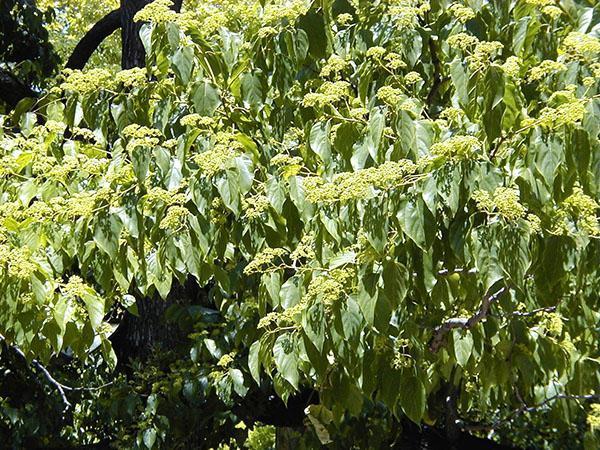 To plant a candy tree, you need to get its seeds somewhere. They must be of good quality, which means they must be stored for no more than 2 years. In addition, you can propagate it with slightly stiff cuttings or using layering. The first shoots are visible at a temperature of 18 ° C. You need to dive young seedlings immediately after the first 2-3 leaves appear on them. The soil for planting must be chosen:
To plant a candy tree, you need to get its seeds somewhere. They must be of good quality, which means they must be stored for no more than 2 years. In addition, you can propagate it with slightly stiff cuttings or using layering. The first shoots are visible at a temperature of 18 ° C. You need to dive young seedlings immediately after the first 2-3 leaves appear on them. The soil for planting must be chosen:
- wet;
- fertile;
- loose;
- with sand, turf and foliage.
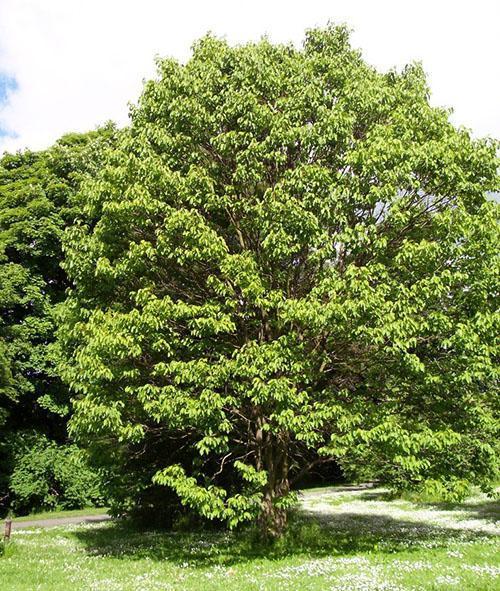 In this case, the site itself must be well lit, as well as protected from drafts and strong winds. Indoor varieties should be constantly watered and sprayed.
In this case, the site itself must be well lit, as well as protected from drafts and strong winds. Indoor varieties should be constantly watered and sprayed.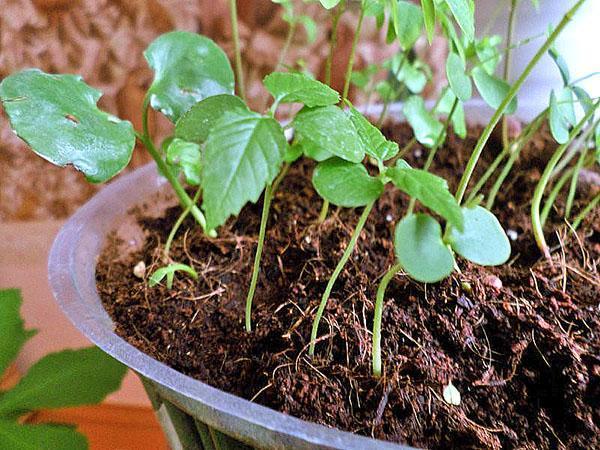 The water should be warm, settled and boiled. Every two years, the plant is recommended to be transplanted into a fresh substrate.
The water should be warm, settled and boiled. Every two years, the plant is recommended to be transplanted into a fresh substrate.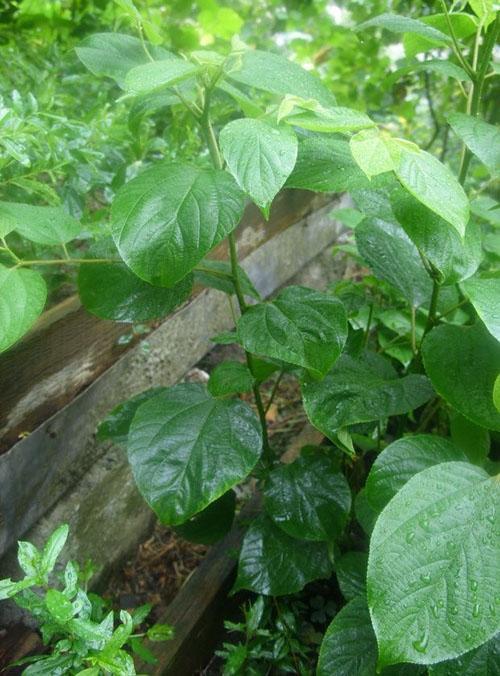 In this case, sick, as well as incorrectly developing shoots must be removed.
In this case, sick, as well as incorrectly developing shoots must be removed.
Young trees, which are up to 4 years old, need to be well wrapped, because they are afraid of freezing. Older garden dwellers can safely tolerate a drop in temperature to -10 ° C, if the cold does not last very long.
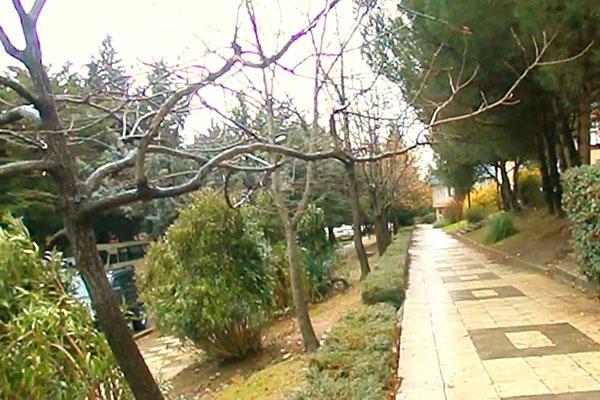 Such an exotic plant is used to decorate greenhouses and gardens located in a subtropical climate. It can also be grown for medicinal purposes.
Such an exotic plant is used to decorate greenhouses and gardens located in a subtropical climate. It can also be grown for medicinal purposes.
Candy tree fruits - video